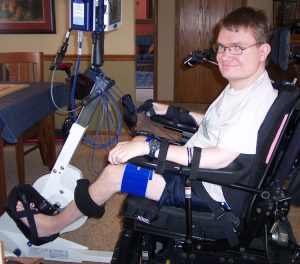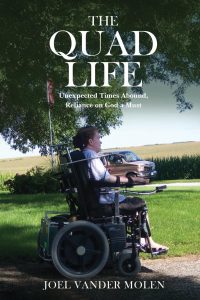Muscle spasms are a normal part of life with a high spinal cord injury. I regularly watch my body slap, hit, grope, and kick myself or anyone around me. They can be annoying at times, but aren’t always a bad thing.
Without having control of my limbs, the muscles don’t get any regular use. Spasms help to maintain muscle mass, improve circulation, and improve bone density. There can be a small margin between helpful spasms and having muscle stiffness interfere with everyday life. Therefore, I do a number of different techniques to help reduce the need for medication and be able to function.
- Go Barefoot Any sort of stimulation can cause muscles to react. This can be from going over a bump in my chair or the van, getting touched, or reaction to clothing. Wearing footwear of any type is a big trigger for my body so I go barefoot for most of the year. There are other benefits as well, but this is the biggest one for me. I suggest anyone give this a try, but be careful for hot footrests in summer sun and cold winters. When temps go below freezing, I use minimalist footwear outside and then remove my shoes and coat when safely indoors.
 P.R.O.M. Passive Range of Motion is something I do four times a day, every day. Caregivers stretch my arms and legs to help reduce spasms and contractions. This is something that widely varies for each individual in amount of stretching and frequency. Work closely with a physical therapist to get a stretching routine established and then work with your caregivers and schedule on how often you can do your program.
P.R.O.M. Passive Range of Motion is something I do four times a day, every day. Caregivers stretch my arms and legs to help reduce spasms and contractions. This is something that widely varies for each individual in amount of stretching and frequency. Work closely with a physical therapist to get a stretching routine established and then work with your caregivers and schedule on how often you can do your program.- F.E.S. Bike Technology has changed quite a bit since I was injured in 1985, and that includes options to help paralyzed muscles. In the summer of 2015, I started using a Functional Electric Stimulation (FES) bike. With electrodes stuck to different muscles on my legs, they receive a pulse that makes them do a biking motion. I was able to get my own bike and try to ride it several times a week. When I have a session, my legs and all muscles are much calmer after the workout. Added bonuses are improved muscle mass, better circulation, and improved mood in seeing and feeling my own legs move.
Even with all these methods to help reduce spasticity, I still take anti-spasm medication as well. I am on the maximum oral dose for Baclofen and Tizanidine in order to be able to function normally. I was able to decrease them with regular time on the FES bike, but they are still required some.

